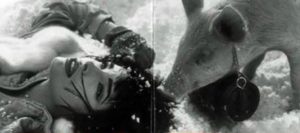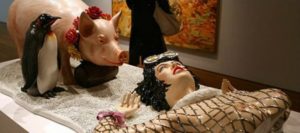The Paris Court of Appeal confirmed a previous decision that found Jeff Koons guilty of copyright infringement for one of his “Banality” sculptures. The Paris Court of Appeal even increased the amount of damages and costs that were initially awarded in the first instance. Beyond the fact that, fortunately, it is quite rare that a famous artist is found guilty of plagiarism, this case is also interesting because Jeff Koons used more or less every defense in the (French) book.
At the end of 2014 and beginning of 2015, the Pompidou Modern Art Museum organized a retrospective of the work of Jeff Koons, which attracted thousands of visitors but gave rise to several lawsuits.
On March 9, 2017, the Paris District Court found that for one of his Banality sculptures, Jeff Koons had reproduced the original features of a French photograph created by Jean François Bauret, which had “saved him creative work.”
The retrospective also prompted another French artist, Franck Davidovici, to sue Jeff Koons personally over an allegedly infringing sculpture. Davidovici also sued Koons’ company, the Pompidou Museum, and Flammarion, a top French publishing house which published a book containing a reproduction of the sculpture in question.
This time, the plaintiff had designed an advert in 1985 for a French fashion company called NAF-NAF. The advert, reproduced below, was published in several well-known magazines, such as “Elle” and “Marie Claire.”

“Naf Naf” is the French name of one of Disney’s Three Little Pigs, the brave and smart one who builds a house with brick and mortar which can resist the wolf’s attack. The title of the advert — “Fait d’hiver” (which means literally “winter event”) — is a play on words since “fait divers” means events, such as accidents, which are reported in local newspapers. The word “winter” also refers to the NAF-NAF autumn-winter collection, which included the jacket worn by the brunette. This photograph is quite striking because the little pig is wearing a small barrel of the type rescue dogs wear.
The Koons sculpture in question was another piece of the Banality series also entitled “Fait d’hiver,” and is reproduced below.

Davidovici claimed that Jeff Koons had violated his moral rights by using the work without his permission and infringed upon his copyright.
Jeff Koons tried almost all defenses that can be raised in this kind of case but none of them was persuasive to the judges and on 8 November 2018 Jeff Koons was found to have infringed Davidovici’s copyright. Jeff Koons appealed but the Paris court of appeal reached the same conclusion and increased the amount of damages and costs awarded.
The Parody Defense: Tried Again, Failed Again
As before the first instance judges, Jeff Koons argued that the sculpture fell within the parody defense.
This defense is set out in the French Intellectual Property Code but is, in fact, the implementation of article 5 §3 (k) of the 2001/29/CE Copyright Directive. The Court quoted a decision rendered by the European Court of Justice that stated that for the exception to apply, the work of art must evoke an existing work but differ notably from that previous work and express humor or mockery.
An example of what would certainly qualify as a parody is the painting by Dali of Mona Lisa with a moustache.
Jeff Koons argued that the humor in his sculpture stemmed from the incongruity of the scene: the woman is lying in the snow, dressed with a sexy fishnet gown and the animal who comes to rescue her was a pig, a farm animal which symbolizes banality. That pig is there to free the young woman from the “fashion diktats” and to free the public from the “good taste diktats” of the so-called “Great Art.”
The Court held that even assuming that the sculpture might be seen as an expression of humor, the advert was not effectively notorious for the sculpture to be regarded as a parody.
The Freedom of Expression Defense: Tried Again, Failed Again
Koons tried once again to rely on freedom of expression as set out in Article 10 of the European Convention of Human Rights but the judges followed the same reasoning as in the Bauret case and also relied on the decision rendered by the European Court of Human Rights in the Ashby Donald case.
Jeff Koons argued that he had added flowers and penguins, which symbolize spring and life, and that his intention was to convey the message that each individual must have faith in his/her own personal tastes. Before the first instance court he had provided as an exhibit a copy of a decision rendered by the U.S. Court of Appeals for the Second Circuit in the Andrea Blanch case in which Koons successfully relied on the “fair use” defense. The French judges could have put this case aside by stating that the “fair use” doctrine simply does not exist under French law but interestingly, they noted that the U.S. case was different in that Koons had not used a substantial part of Blanch’s work. On appeal, the U.S. case was not discussed.
The French judges followed the European case law and stated that they had to balance on the one hand the interests of Davidovoci and on the other hand, Koons’s freedom of expression. Their conclusion was that it was not disproportionate to allow the plaintiff to enforce his rights.
Freedom of expression was therefore not a valid defense in this case.
The Cost of this Banality
A total amount of 207,000 euros had been awarded by the first instance court by way of damages and legal fees and the co-defendants, including the Pompidou Museum, were held jointly liable to pay that amount, which is fairly usual in copyright infringement cases. On appeal, the total amount payable was increased to 344,000 euros, which is quite high according to French standards.
Koons would have been well advised not to appeal but it is harder to predict the outcome of a judicial battle than that of a fairy tale.
Pour ceux d’entre vous qui lisent le français, vous trouverez une analyse plus détaillée de cette décision dans l’article que nous avons publié dans la Revue.



 />i
/>i

